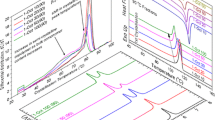Abstract
An outline is given of the development of temperature rising elution fractionation (TREF) technique for polymer separation on the basis of crystallizability. The TREF technique has found application mainly in the area of analysis of semi-crystalline polyolefins and its development has been significantly influenced by the desire to establish the structure of linear low density polyethylenes. These materials exhibit an unusually broad distribution of comonomer which can be readily explored by TREF. Systems have been developed which can provide fractionation on a preparative scale, where recovery of fractions for further analysis is desirable and more recently on a small scale, where rapid analysis using detectors provide refined crystallizability distributions. A description is given of these fractionation systems along with a discussion of the separation mechanism and the significance of controlling the crystallization step to achieve fractionation efficiency.
Application of TREF is discussed with reference to low density polyethylenes made by both the high and low pressure process, ethylene vinyl acetate copolymers and poly-propylenes. The value of TREF for analysis of polymer blends is emphasized along with the potential for cross-fractionation combining TREF with a molecular weight fractionation for detailed analysis of polymer structure. Finally the point is made that TREF is becoming much more widely used and accepted as a technique for structural evaluation. Further improvements in instrumentation and techniques for controlling the crystallization step are expected. These will further enhance the usefulness of TREF and pave the way for its greater use both in the area of polyolefins as well as for other crystalline polymer systems.
Preview
Unable to display preview. Download preview PDF.
Similar content being viewed by others
Abbreviations
- α-CN:
-
α-chloronaphthalene
- o-DCB:
-
ortho-dichlorobenzene
- DEC:
-
Decalin
- DMA:
-
Dynamic Mechanical Analysis
- DSC:
-
Differential scanning calorimetry
- DTA:
-
Differential Thermal Analysis
- EA:
-
Ethylene-ethyl acrylate copolymer
- EB:
-
Ethylene-butene copolymer
- EP:
-
Ethylene-propylene copolymer
- EPDM:
-
Ethylene-propylene-diene terpolymer
- EPR:
-
Ethylene-propylene rubber
- EVA:
-
Ethylene-vinyl acetate copolymer
- GEF:
-
Gradient elution fractionation
- HDPE:
-
High density polyethylene
- IR:
-
Infra-red
- IV:
-
Intrinsic Viscosity
- LDPE:
-
Low density polyethylene
- LLDPE:
-
Linear low density polyethylene
- MFI:
-
Melt flow index
- MI:
-
Melt index
- 4-MP-1:
-
4-methyl pentene-1
- MWD:
-
Molecular weight distribution
- NMR:
-
Nuclear magnetic resonance
- PIB:
-
Polyisobutylene
- PP:
-
Polypropylene
- RI:
-
Refractive index
- SCB:
-
Short-chain branching
- SEC:
-
Size exclusion chromatography
- TCB:
-
Tri-chlorobenzene
- TREF:
-
Temperature rising elution fractionation
- VLDPE:
-
Very low density polyethylene
- C:
-
Carbon atom
- C=C:
-
Vinyl group
- ΔH:
-
Heat of fusion
- M:
-
Molecular weight
- NA :
-
Mole fraction of comonomer units
- R:
-
Gas constant
- r1 · r2 :
-
Reactivity ratio
- Tm :
-
Melting temperature
- v:
-
volume fraction
- V:
-
Molar volume
- \(\bar x\) :
-
Average degree of polymerization
- χ:
-
Interaction parameter
- [η]:
-
Intrinsic viscosity
References
Shirayama K, Okada T and Kita S (1965) J Polym Sci A-2, 3: 907
Desreux V and Spiegels MC (1950) Bull Soc Chim Belg 59: 476
Schneider NS (1965) J Polym Sci C 8: 179
Moore JC (1964) J Polymer Sci A 2: 835
Kamath P and Wild L (1966) Polym Eng Sci 6: 213
Wijga PW, van Schooten J and Boerma J (1960) Makromol Chem 36: 115
Bergström C and Avela E (1979) J Appl Polym Sci 23: 163
Wild L and Ryle T (1977) Polym Preprint Am Chem Soc 18: 182
Wild L, Ryle D, Knobeloch D and Peat I (1982) J Polym Sci Polym Phys Ed 20: 441
Usami T, Gotoh Y and Takayama S (1986) Macromols 19: 2722
Kelusky EC, Elston CT and Murray RE (1987) Polym Eng Sci 27: 1562
Hazlitt LA and Moldovan DG (1989) US Pat 4,798,081
Wild L (February 1989) SPE Polyolefins VI Conference Prepr 413
Knobeloch DC and Wild L (February 1984) SPE Polyolefins IV Conference Prepr 427
Nakano S and Goto Y (1981) J Appl Polym Sci 26: 4217
Flory PJ (1955) Trans Faraday Soc 51: 848
Prasad A and Mandelkern L (1989) Macromols 22: 914
Pavan A, Provasoli A, Moraglio G and Zambelli A (1977) Makromol Chem 178: 1099
Hosoda A (1988) Polym J 20: 5, 383
Shirayama K, Kita S and Watabe H (1972) Makromol Chem 151: 97
Roedel MJ (1953) J Am Chem Soc 75: 6110
Raff RAV and Doak KW (1964) Crystalline Olefin Polymers, Interscience New York
Kulin LI, Meijerink NL and Starck P (1988) Pure & Appl Chem 60 9: 1403
Elston CT (1972) US Pat 3,645,992
Wild L, Ryle TR and Knobeloch DC (1982) Polym Preprint Am Chem Soc 23: 133
Mirabella FM Jr and Ford EA (1987) J Polym Sci Polym Phys Ed 25: 777
Karoglanian S and Harrison IR (1989) Am Chem Soc Proceedings Pol Mat Sci and Eng 61: 748
Mathot VBF (1984) PRI and SPE Polycon '84 LLDPE papers and Proceedings 1
Wilfong D and Knight GW (1989) Am Chem Soc Proceedings Pol Mat Sci and Eng 61: 743
Cady LD (1977) Plast Eng 43 (1): 25
Natta G, Mazzanti G, Crespi G and Moraglio G (1957) Chim Ind (Milan) 39: 275
Kawamura H, Hayashi T, Inoue Y and Chujo R (1989) Macromols 22: 2181
Doi Y, Suzuki E and Keili T (1981) Makromol Chem Rapid Commun 2: 293
Kakugo M, Miyatake T, Mizunuma K and Kawai Y (1988) Macromols 21: 2309
Author information
Authors and Affiliations
Rights and permissions
Copyright information
© 1990 Springer-Verlag
About this paper
Cite this paper
Wild, L., Glöckner, G. (1990). Temperature rising elution fractionation. In: Separation Techniques Thermodynamics Liquid Crystal Polymers. Advances in Polymer Science, vol 98. Springer, Berlin, Heidelberg. https://doi.org/10.1007/3-540-53135-1_4
Download citation
DOI: https://doi.org/10.1007/3-540-53135-1_4
Published:
Publisher Name: Springer, Berlin, Heidelberg
Print ISBN: 978-3-540-53135-7
Online ISBN: 978-3-540-46724-3
eBook Packages: Springer Book Archive




